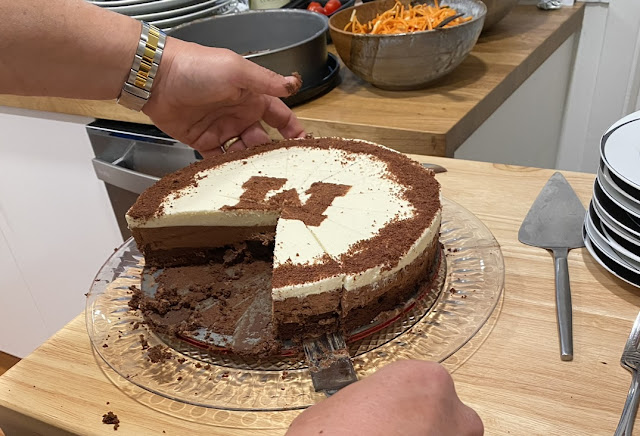Would it surprise you to learn that during the Victorian era, historians (all men) revised the historic record to support the theory that great men are the only important actors of significance in the past? It shouldn’t be a surprise — but it is definitely interesting to read a book about the actual details of the lives of the great women in Medieval times. The accomplishments and often the power and economic advantages of these women were denigrated or just erased from the historic works of the 19th century, and remained forgotten until fairly recently. Though she is not the first recent writer to restore them to the history books, their portrayals make a very interesting subject for Janina Ramirez’s recent book.
 |
Femina: A New History of the Middle Ages Through the Women Written Out of It
by Janina Ramirez. Published 2022. |
Ramirez begins most of the chapters in the book with a description of a modern discovery or event that relates to the medieval woman featured in the chapter. For example she might present an archaeology dig that was done under an old English shrine, a revealing DNA test of a seemingly male Viking woman’s skeleton, the issues involved in restoring the Bayeux Tapestry, or even the discovery of a copy of a lost medieval book in a closet in an English country house. She then usually describes a scene in the medieval town where the woman lived or an event they experienced, for background. She continues with a portrait or biography of the featured woman and her life circumstances in as much detail as is historically available.
An archaeology dig often reveals a skeleton or an artifact linked to a fascinating story of a women's life in the early Middle Ages. Sometimes as I read I was thinking about Ruth Galloway, the fictitious archaeologist and amateur detective in the long series of books by Elly Griffiths. Ruth Galloway lives, digs, and detects in the town of King's Lynn, which also happens to be the home of one of the women featured in Femina: the writer and mystic Margery Kemp (b. 1373), “an ordinary married woman, mother to fourteen children.” Ramirez convinces me that such discoveries are much richer than the fictional ones. She makes the reader see the unexpected parts of history, the parts about women and their vigorous and active role in the times when they lived, and especially the way they traveled. Margery went all over, even to the Holy Land!
I was fascinated by several of the subjects of Ramirez's book, especially the Viking women who sometimes dressed as men and may have been warriors, and of several other women who overstepped the expectations for women of the time. I. have written summaries below of a few of the places and people I learned about while reading Ramirez's book, illustrated with some of her pictures. The Kindle edition has only black and white images, but I've found colored versions on the web, because color is often important in her descriptions. I've only excerpted a very small part of each of these discussions, and only chosen a few of the many fascinating portraits in the book.
The Lichfield Angel
 |
| "The Lichfield Angel" |
This is a limestone carving of an angel dated 800 CE, excavated in 2003, from the shrine of Saint Chad (d. 672), first Anglo-Saxon Bishop of the Mercians of Lichfield. The town of Lichfield was very briefly important in the 8th century, in the reign of King Offa and Queen Cynethryth of Mercia, one of the English kingdoms in the era before William the Conqueror. The angel was found in an archaeological exploration underneath the modern shrine in 2003. Ramirez uses the sculpture as an example of the fine craftsmanship of the time, pointing out that traces of color on the stone show that sculpture then was painted, not left white. The style echos classical art that was still a big influence in this era. Offa and Cynethryth perceived themselves as cultural rivals of Charlemagne, then the ruler of much of Europe.
The Bayeux Tapestry is in fact a work of embroidery, not tapestry, which is made by weaving. The work "is an extraordinary medieval survival, depicting the events leading up to the Battle of Hastings of 1066, culminating in William the Conqueror’s defeat of King Harold." (
Femina, p. 132). While it is held in the city of Bayeux, France, it was probably made in Canterbury, England. Its huge size shows that it had to be embroidered by a team of women working together to a central plan. Ramirez discusses the work from a variety of points of view, both as a work of women’s art, a historical document, and a former decoration for a very large cathedral. A reconstruction of how it looked in the church is shown above. Ramirez also discusses one panel of the textile:
 |
Queen Edith at the deathbed of her husband, Edward the Confessor.
From one panel of the huge Bayeux Tapestry. Edith is the only identifiable woman portrayed in the work. |
Queen Edith survived her husband and managed to retain wealth and power despite the death of her brothers and the conquest by William the Conqueror. She commissioned a book about her late husband and her family, and may have also been at least partly responsible for the creation of the Bayeux Tapestry, which is a highly important source of information about the era. Her early life: she came from a rich and powerful family, and is compared to an earlier powerful woman named Emma:
"Edith was a patron of the church and of the arts. She gave lands to the abbey in Abingdon and the see of Wells, and sponsored artists in her role of tending to the king’s regal presentation. She commissioned items of clothing and jewellery, keeping a goldsmith as one of her tenants. Through her expansive land-holding, ruthless decision-making and political engineering she overtook Emma, becoming by the time of the Norman Conquest the richest woman in England and the fourth-richest individual after her husband, her brother and the Archbishop of Canterbury." (Femina, pp. 165-166).
After the conquest:
"Edith spent most of the latter part of her life in her dowry city of Winchester, where she had access to manuscript art, and at Wilton, where a team of skilled embroiderers could have been developed. She is recorded as having been an excellent embroiderer herself and certainly knew a good deal about working fine fabrics, since she commissioned and oversaw the production of high-status clothing for her husband. She was also witness to scenes depicted on the tapestry and would have had first-hand accounts of the battle in which she lost three brothers – all of whom are memorialised in its stitches. The events of 1066 were incredibly disruptive for English women, many of whom lost male relatives and lived in fear of being forcibly married to Norman incomers. The number of nuns swelled as women sought sanctuary in convents. This would have provided Edith with a growing body of skilled, dedicated embroiderers capable of completing a project as demanding as the Bayeux Tapestry. The argument is compelling, but once again, it is not possible to say with any certainty that Edith was involved in the creation of the tapestry. True, she is the only identifiable woman stitched onto its scenes, and she had good reason to produce it. But the arguments in favour of Odo as patron remain strong. Ultimately, all we can confidently deduce is that her influential position means she was capable of such an undertaking, and reminds us that eleventh-century women could be patrons and producers of art. Emma, Edith and the women who embroidered the Bayeux Tapestry played a large but mostly uncredited part in the male-orientated accounts of dukes." (pp. 167-168).
Saint Jadwiga's Purse
 |
Purse made in France in 1340, used for alms by Saint Jadwiga of Poland.
The front and back of the purse illustrate part of the story of Tristan and Isolde. |
Where artifacts exist, Ramirez tells us about them and about their significance. Jadwiga (or Hedwig) was "the one and only female ‘king’ of Poland. In fact, she and her sister Mary, who was declared King of Hungary, are two of the only women in Europe to have held the title of ‘Rex’ rather than ‘Regina’. But Jadwiga has been misunderstood, misrepresented and misused down the centuries." (p. 246). Her beautiful purse is held in the Wawel cathedral of Kraków. Ramirez views Jadwiga's life story as it is related to the chivalrous tale of Tristan and Isolde. Here is this real-life tale:
"Jadwiga’s love life has all the elements of a tragic romance. As a toddler she’s told she will marry William, heir to the Austrian dynasty. At five years old, she takes part in a glorious chivalric ceremony where her eight-year-old fiancé declares he will marry her in front of the most important leaders on the world stage. This was no doubt a terrifying situation for a young girl to find herself in, but the glamour, riches and ritual could not have been lost on her. The knowledge that she would eventually marry this boy dictated her early years. She lived in his court in Vienna, developing into an educated and courtly child, fluent in many languages and educated in matters of church and state. She read romances, in which beautiful princesses fell in love with powerful knights and pursued an idealised courtly love which morally enriched both parties. But after her father’s death everything changed. She could only become King of Poland if she became a resident of Kraków and accepted her advisers’ choice of husband. And they had their eyes on someone else." (pp. 255-256).
Political considerations made the nobles of Krakow prefer for this female heir to the throne to marry Lithuania’s Grand Duke Jagiełło. However, before they can be married, William shows up to claim his betrothed, and she forces her way out of the castle:
"Having escaped her watch, the teenage Jadwiga reunited with William and the couple danced together one last time in the refectory of St Francis’s Monastery in the city. But ultimately Jadwiga turned him away, choosing instead to follow the advice of the decision-makers of Poland." (p. 257).
Jadwiga's life after she eventually married Jagiełło involved politics, wars, and above all overseeing the conversion to Catholicism of his still-pagan land, Lithuania, and the subduing of the order of Teutonic Knights who had been trying to convert them violently. After a somewhat wild youth spent as a famous part of a romantic triangle, she became a devout Catholic, and continued to be admired and supported in her efforts by the Pope, and she founded various church institutions in Poland, and did many other things while reigning as King of Poland. Objects that she used or donated to the church include the purse, a manuscript, and a famous large cross that still hangs in the cathedral. She lived only to age 26, and died in 1399, shortly after giving birth: death as a result of childbirth was excruciatingly common for women in that era.
The piety and success that Jadwiga exhibited in promoting Catholicism was the motivation for her being made a saint in 1997 by Pope John Paul II. The story of how her identity and memory have been used and manipulated by Polish patriots and other political actors in history is complicated and her sainthood is a kind of culmination of many such factors, but her actual life is much more interesting, as shown in Ramirez's account.
Overall, a Good Book!
There are so many stories about women in the Middle Ages, how they lived, how they were remembered over time, how they were forgotten or their stories repressed, and how they have been rediscovered in our time. And I didn’t even get around to the Viking women, who were so wonderfully colorful and lived such daring lives.
Blog post/review © 2023 mae sander.


















































